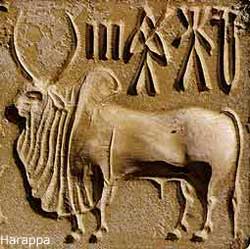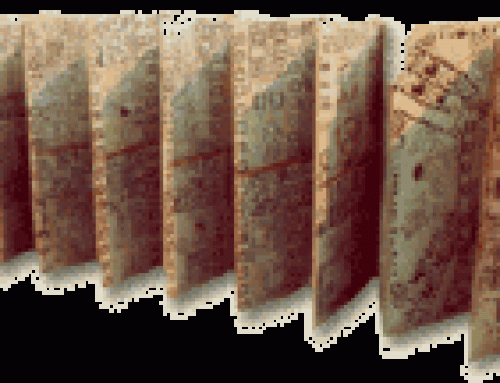
Harappan Seal
One of the earliest known writing systems came from India, probably around 2500 BC. Unfortunately, nobody can read the Harappan writing yet. But we know people were using this writing to mark their property, so other people couldn’t steal it, and to keep track of things. The writing was in pictographs, like Egyptian hieroglyphs.

Sanskrit version of the Rig Veda
After the Indo-European invasion, about 1500 BC, the Harappan writing was forgotten, and nobody in India could write at all for the next thousand years.
When people did start to write again, around 500 BC, they were probably inspired by the relatively new alphabetic writing of West Asia. Indians may have learned the alphabet from Iranian traders along the Silk Road. They used it to write their own Indo-European language, Sanskrit. The letters are called Brahmi. One of the first things they wrote down with the new alphabet was a poem called the Rig Veda. There were three other Vedas as well but they are less famous. They also wrote down the Upanishads, which are commentaries and explanations of the Vedas.
Once Indian writers got going, they kept going. Around 300 BC, people wrote down the Ramayana, a long story about Prince Rama and his wife Sita. And they also wrote down the Mahabharata. Part of the Mahabharata is the Bhagavad Gita, a lot of advice about the law and how people should behave. Another part is the earliest version of the Cinderella story: the story of Shakuntala.
About the same time, Buddhist writers started to collect traditional stories called Jataka tales and write them down too. Most of these stories have a lesson or a moral: they are the origins of the English stories of Chicken Little and the Goose that Laid the Golden Egg and many others. Many of the Greek stories we know as Aesop’s Fables also come from older Jataka tales. Many other Jataka tales have Buddhist morals about the importance of freeing yourself from the wheel of reincarnation.
When many people in northern India converted to Islam in the 1100s AD, they began to read Arabic stories and poetry, and many writers found new inspiration there. Lalla Arifa, for example, was a Sufi woman who wrote in the 1300s AD. She wrote short poems about being abused by her husband and her husband’s family at home, and about leaving him to become a Sufi religious leader.





and i oop